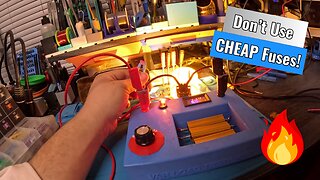Premium Only Content

Fasting activates macro-autophagy, Xigui Chen. A Puke(TM) Audiopaper.
https://www.nature.com/articles/srep12115
https://rumble.com/v3t4yzj-index-of-science.-music-by-dan-vasc.html
Fasting activates macro-autophagy in neurons of an Alzheimer’s disease mouse model, but it is insufficient to degrade amyloid-beta.
Xigui Chen, Department of Neuropathology, Medical Research Institute, Tokyo Medical and Dental University, Japan, and others.
We developed a new technique to observe macro autophagy in the brain in vivo, and examined whether fasting induced macro-autophagy in neurons, and how the induction was different between Alzheimer’s disease (AD) model and control mice. Lentivirus for EGFP-LC3 injected into the brain successfully visualized auto-phagosome in living neurons by two-photon microscopy. The time-lapse imaging revealed that fasting increased the number, size and signal intensity of auto-phagosome in neurons. In AD model mice, these parameters of auto-phagosome were higher at the basal levels before starvation, and increased more rapidly by fasting than in control mice. However, the metabolism of exogenous labeled A Beta evaluated by the new technique suggested that the activated macro-autophagy was insufficient to degrade the intracellular A Beta increased by enhanced uptake from extracellular space after fasting. Ordinary immunohistochemistry also revealed that fasting increased intracellular accumulation of endogenous A Beta, triggered cell dysfunction but mostly did not decrease extracellular A Beta accumulation. Moreover, we unexpectedly discovered a circadian rhythm of basal level of macro autophagy. These results revealed new aspects of neuronal autophagy in normal, AD states and indicated usefulness of our method for evaluating autophagy functions in vivo.
Autophagy, especially macro-autophagy mediated by auto phagosomes, has been implicated in various neurodegenerative diseases including AD. Ultrastructural analysis of postmortem human AD brains revealed increased auto phagosomes in dystrophic neurites. Macro autophagy was also suggested to be a pathway of generating amyloid beta (A Beta) in the cytoplasm. Meanwhile autophagy-related genes were induced in autopsy brains of AD patients and auto phagosomes were co-localized not only with A Beta in AD but also with a-synuclein and tau aggregation in autopsy brains of Parkinson’s disease and frontotemporal lobar degeneration, suggesting that misfolded disease proteins might generally induce autophagy.
Some neurodegenerative diseases have more direct relationships to autophagy. Familial Parkinson’s disease causative proteins, PARK2, Parkin and PARK6, PINK1 act as indicators of functionally abnormal mitochondria to induce mitophagy. Hereditary spastic paraparesis type 15 are linked to mutations of the SPG15 gene that promotes autophagosome maturation. Mutations of an adaptor protein for selective autophagy, p62 are associated with amyotrophic lateral sclerosis, ALS. In vivo analysis of autophagy after nutritional starvation was performed in a pioneering work by Mizushima, Ohsumi and their colleagues with LC3-GFP transgenic mice, but induction of macro-autophagy was not detected in the brain tissues after fixation. Meanwhile, it was reported thereafter that inhibition of m TOR induced autophagy and ameliorated poly-glutamine disease pathology. Moreover, autophagic response of neurons might be conditional. In contrast to inducible autophagy, constitutive autophagy is established to protect neurons in vivo from neurodegeneration through clearance of ubiquitinated proteins.
The discrepancy awaits further analysis with a new technique to observe living neurons to settle the issue of in vivo.
Results.
A new method of in vivo imaging of macro autophagy in the brain of living animals based on two-photon microscopy.
To visualize auto phagic vacuoles in living neurons in the brain, we generated lentiviral vector expressing EGFP-LC3. We injected 5 micro liters of lentiviral vector, titer 5 million vector genomes per milliliter, into retrosplenial dysgranular cortex (RSD) or cerebellar cortex. Twenty days after injection the mice were investigated by two-photon microscopy, FV1000 MPE2, Olympus, Japan, with the thin skull method as described in Methods. In both areas, clustered EGFP-positive vesicles and dispersed fine EGFP-positive dots were observed, Figure 1a. Especially in the cerebellar cortex, the vesicles with high intensities were clustered in a narrow area of 10 to 20 micron diameter, suggesting that they correspond to the cell body of Purkinje cells aligned in a single layer, Figure 1a, Supplementary Figure 1. In reconstructed images of the cerebellum, EGFP-LC3 vesicles were also aligned in the main dendrite of Purkinje cells, Supplementary Figure 1.
To verify that such clusters of EGFP-LC3 vesicles actually corresponded to the cell body of Purkinje cells, we used double transgenic mice, loxP-flanked STOP cassette Td Tomato by Ptf1a-promoter-Cre, that express red fluorescent protein in GABAergic Purkinje cells in the cerebellum. Infected lentiviral vector actually expressed EGFP-LC3 protein in Purkinje cells, a part of granule cells, but not in Td Tomato positive GABAergic neurons in molecular cell layer, see Supplementary Figure 2. To verify the expression of EGFP-LC3 in cortical neurons, we performed immunohistochemistry with anti-NeuN or GFAP antibody and examined co-localization of non-stained native EGFP-LC3 with a cell-specific marker, Figure 1b. The result revealed EGFP-LC3 vesicles, dots were distributed in NeuN-positive neurons, Figure 1b. GFAP positive astrocytes might also possess EGFP-LC3-positive dots, while the signals were weak in comparison to neuronal EGFP-LC3 vesicles, Figure 1b.
On the other hand, infection of AAV-EGFP generated diffuse intracellular signals of EGFP, Figure 1c, supporting that the EGFP-LC3 vesicles were not the artificial self-aggregates of EGFP as reported. Moreover, we found by confocal microscopy that a part of the EGFP-LC3 vesicles was co-stained with a lysosome marker, LAMP2A in brain tissues, indicating that these EGFP-LC3 vesicles were actually fused with lysosomes, Figure 1d.
Starvation-dependent induction and circadian rhythm of macro autophagy in neurons.
Since these results supported usefulness of two-photon microscopic observation of EGFP-LC3 for evaluation of macro autophagy, we applied the technique to answer the questions:
1) Whether fasting treatment induces macro autophagy in neurons and
2) How the auto phagic response is different between 5XFAD mice, one of the severest mouse AD models that firstly shows A Beta deposition at 3 months of age, and the background mice, C57BL, 6 times SJL, Figure 2.
We firstly examined the effect of fasting treatment on body weight and blood glucose, and confirmed that 5XFAD and background mice showed similar responses to fasting in these parameters, Supplementary Figure 3. In this experiment, 20 days after injection of EGFP-LC3 lentivirus, the mice were fasted and supplied only with water for 48 hours, Figure 2a. Two-photon microscopic observation was performed at 0, 6, 12, 24 and 48 hour time points during fasting, Figure 2a. Using the vessels as markers, the position of observation was strictly controlled, Supplementary Figure 4.
Before analyzing the effect of fasting, we needed to test whether auto phagosome formation possesses a circadian rhythm, Supplementary Figure 5, because it had not been investigated previously.
Unexpectedly, our live imaging of the brain revealed that the number, volume, and signal intensity per cell of the EGFP-LC3 vesicles changed in a circadian rhythm pattern, Supplementary Figure 5. All the parameters increased during daytime (light) and decreased in nighttime, dark. Interestingly, however, the parameters started to decrease around 4 PM when mice do not eat much, Supplementary Figure 5, suggesting that the circadian rhythm genes might affect auto phagosome formation independently of feeding behavior. However, the question whether circadian rhythm genes affect auto phagosome formation through or not through feeding behavior is an open question requiring further investigation.
Therefore we started the observation strictly at the same time points to evaluate the response of autophagosome to the fasting treatment, Figure 2a, b. Two photon microscopy images, 100 micron by 100 micron by 100 micron volume, were obtained from four groups of mice. The number, signal intensity and volume of EGFP-LC3 vesicles were quantified and their mean and SD were calculated, Figure 2c. More than five mice were analyzed in each group of 5XFAD fasting, 5XFAD non-fasting, Wt fasting and Wt non-fasting mice, respectively, Figure 2c. Detailed methods for acquiring these parameters are described in the Methods section. The time-lapse live imaging revealed that basal levels of EGFP-LC3 vesicles were higher in 5XFAD mice at the number, intensity, and total volume of vesicles per cell but not the average size of puncta, Figure 2c. In addition, when these values were corrected by the basal values in each mouse group, the increasing ratio was also higher in 5XFAD mice, Figure 2c.
We also employed an ordinary immune-histo-chemistry method with postmortem brains of 5XFAD mice after fasting treatment to detect endogenous LC3 vesicles. In this analysis, sensitivity of the endogenous LC3 detection was far lower than that of AAV-EGFP-LC3 by our new method, and it was hard to evaluate the number of macro auto phagosome strictly.
However, the result of LC3 signals still suggested induction of macro auto phagosome after fasting, which was generally observed across multiple brain regions, Figure 2d.
Figure 1. In vivo imaging of macro autophagy in neurons.
(a) EGFP-LC3 lentivirus was injected into the cerebellar cortex (left panel) and retrosplenial dysgranular cortex (RSD, right panel) of wild type mice (C57BL, 6 by SJL) at 3 months of age. Twenty days later, EGFP-LC3 signals were directly observed by two photon microscopy. The EGFP-positive vesicles were distributed in a group as if they were auto phagosomes in a cell.
(b) The brain tissues of wild type mice injected with EGFP-LC3 lentivirus were immunostained with anti-NeuN and GFAP antibodies. EGFP-LC3 vesicles surrounded NeuN-positive neuronal nuclei, yellow arrows, indicating that they were auto phagosomes in neurons. Such distributions of EGFP-LC3 were not found in GFAP-positive astrocytes, white arrowhead, suggesting that most EGFP-LC3 vesicles were located in neurons. EGFP-LC3 was directly observed without immunostaining in these experiments.
(c) Two-photon microscopic observation of the RSD region of AAV-EGFP-injected wild type and 5XFAD mice at 3 months. Both genotypes of mice showed homogeneous signals of EGFP in cells, supporting the specificity of EGFP-LC3 signals.
(d) Colocalization of a part of EGFP-LC3 vesicles with LAMP2A in RSD region of 5XFAD mice at 3 months.
Figure 2. In vivo imaging of auto phagosome in AD model and control mice.
(a) Experimental protocol of the in vivo time-lapse imaging to test the effect of fasting on auto phagosome formation.
(b) Time-lapse imaging of EGFP-LC3 vesicles was performed at a similar region of AD model and control mice at 3 months with or without fasting. The signal intensities were higher in 5XFAD mice than control mice before fasting. Fasting induced the increase of signal intensities in both genotypes, while the induction was more prominent in 5XFAD mice.
(c) Quantitative analyses of the chronological changes of EGFP-LC3 vesicles with or without fasting.
In mean signal intensity per cell, mean vesicle number per cell, and mean vesicle volume per cell, the values were higher in 5XFAD mice than control mice. Some of these values were also increased more remarkably in 5XFAD mice than control mice. The mean volume of the vesicles was not changed so remarkably. More information is included in the text of the paper.
Effect of starvation-induced macroautophagy on extracellular and intracellular A Beta accumulation.
Finally, we tested whether induced auto phagosome was really effective for degradation of A Beta because it was reported previously that AD-asscociated mutation of presenilin-1 impairs autolysosome acidification and cathepsin activation to inhibit proceeding of autophagy processes. Such a dysfunction in macro autophagy might occur in 5XFAD mice and might prevent degradation of the substrates within auto phagosomes after fusion with lysosomes. For this purpose, we injected A Beta labelled with TAMRA into the retrosplenial dysgranular cortex (RSD), the brain area that corresponds to human precuneus, and observed dynamics of A Beta by time-lapse imaging for 2 days from 24 hours after injection, Figure 3a.
The experiment might mimic over-secretion of A Beta from hyperactivated neurons in brain regions composing the default mode neural network. First we found that injected A Beta was taken up into neurons within 24 hours after injection, Figure 3b. Importantly, the amount of A Beta (red vesicle) in neurons was obviously higher in 5XFAD mice, Figure 3b,c. The increase of intracellular A Beta could be explained by increased uptake of extracellular A Beta by endocytosis. Analysis of the yellow vesicle volume per cell that reflects secondary lysosome, the fused vesicle of endosome and autophagosome, revealed that the amount of secondary lysosome increased in neurons during the time of fasting whereas in which A Beta remained undegraded, Figure 3c. The increase of such “residual body” containing A Beta was observed both in wild type and 5XFAD mice, while the extent of increase was more remarkable in 5XFAD mice, Figure 3c.
Figure 3. Endocytosis and auto phagosome-dependent degradation of A Beta by cortical neurons.
(a) Experimental protocol of the chronological in vivo imaging to test A Beta uptake and degradation in the cortical neurons is shown.
(b) Time lapse imaging of TAMRA Beta amyloid (upper panels) and TAMRA Beta amyloid plus EGFP-LC3 vesicles (lower panels) at 24, 0, 48, 24, 60, 36, and 72, 48, hours after injection of TAMRA Beta amyloid. Interaction between endosomes (red) and auto phagosomes (green) were observed chronologically.
(c) Quantitative analyses of the chronological changes of endosomes, TAMRA Beta amyloidpositive vesicles, left graph, and secondary lysosomes, TAMRA Beta amyloid and EGFP-LC3 double positive vesicles, right graph, with or without fasting.
More information in the text of the paper.
Figure 4. Fasting treatment does not affect extracellular A Beta accumulation.
(a) Images of A Beta at various brain regions of 5XFAD mice with or without fasting at 3 months. DAB satin was used to visualize the antibody reaction. No obvious difference was detected in intracellular and extracellular A Beta accumulation between fasting (minus) and fasting (plus) groups at all brain regions.
Abbreviations.
RSD, retrosplenial dysgranular cortex. FC, frontal cortex. LSV, ventral part of lateral septal nucleus.
VM, ventromedial thalamic nucleus. PnC, caudal pontine reticular nucleus. OB, olfactory bulb. Sub, subiculum. CA1, hippocampus CA1. CA2, hippocampus CA2. CA3, hippocampus CA3. DG, dentate gyrus. Cbm, cerebellum.
(b) Images of A Beta visualized by fluorescent secondary antibody at various brain regions of 5XFAD mice with or without fasting at 3 months. No obvious difference was detected in intracellular and extracellular A Beta accumulation between fasting (minus) and fasting (plus) groups at all brain regions.
(c) DAB staining of sagittal sections revealed that extracellular A Beta accumulation was decreased in visual cortex, arrows.
For the comparison of the effect of fasting treatment on A Beta accumulation across different regions of the brain, we employed a method using the post-fixed brain samples of 5XFAD mice at 3 months taking the advantage of the pathological stage. In this case we observed the effect of fasting on accumulation of endogenous A Beta of 5XFAD mice instead of exogenous A Beta TAMRA. The DAB and fluorescence immunostainings with anti-A Beta antibody revealed no significant difference of extracellular A Beta accumulation between non-fasting and fasting groups of 5XFAD mice in most brain regions, Figure 4a,b. However, we detected a tendency that extracellular A Beta accumulation was decreased in visual cortex in fasting groups of 5XFAD mice, Figure 4c. Intracellular A Beta accumulation was also confirmed across different brain regions as we reported previously.
Also unexpectedly, we observed that intracellular A Beta accumulation accompanies blurring or fading-out of DAPI or NeuN stains of the nuclei of neurons, Figure 5a,b. This suggested that a certain type of cell death was induced by intracellular A Beta accumulation and that extracellular plaque formation might be triggered by the seed of A Beta foci of ghost neurons, the residual intracellular A Beta accumulation of dead neurons. Indeed, we often observed various images supporting the progression from intracellular to extracellular A Beta aggregates, Figure 5c, and queer ballooning’s of the cytoplasm and apoptoic changes of the nuclei in intracellular A Beta positive cells, Figure 5d.
Hence, we categorized such types of cells with intracellular A Beta accumulation into three groups, vital cells with clear nuclear margin with DAPI stains (Group A); dying cells with blurred or faint DAPI nuclear stains (Group B); and dead cells with the defect of DAPI nuclear shape (Group C), Figure 5a.
Quantitative analysis revealed that the total cell number of neurons with intracellular A Beta accumulation was increased by fasting treatment generally in all brain regions, Figure 5e. Quantification of each group revealed that fasting treatment induced a shift from A to C generally in all regions of the brain, Figure 5e. These results were consistent with the hypothesis that intracellular A Beta accumulation triggers the cell death and that plaque formation is seeded by the ghost of intracellular A Beta accumulation, whereas this hypothesis should be examined more extensively by employing additional methods in the future.
Figure 5. Intracellular A Beta accumulation was affected by fasting.
(a) Various forms of intracellular A Beta accumulation observed in the cortex of 5XFAD mice at 3 months. Accumulation of intracellular A Beta often accompanied with blurring or fading out of the nuclei, thus the were aligned with hypothetical progression of the cell pathology. Intracellular A Beta positive cells with intact nuclei, with abnormal nuclei, and with no nuclei are classified to group A, B and C, respectively.
(b) Co-staining of NeuN and A Beta revealed that neurons are the cells possessing intracellular A Beta accumulation.
(c) Hypothetical progression of extracellular A Beta aggregates from the seed of intracellular A Beta accumulation is shown with representative images in RSD of 5XFAD mice at 3 months. White arrows suggest the defect of dead neurons. Yellow arrows suggested an enlarged nucleus with abnormal DAPI stains of the nucleus.
(d) Abnormal ballooning of cells with intracellular A Beta accumulation suggesting atypical cell death.
(e) Quantitative analysis of the number of group A, B and C cells at various brain regions in fasting and non-fasting 5XFAD mice at 3 months. P-values for comparison in each group or total cell numbers between fasting and non-fasting were calculated by Welch’s test.
Discussion.
Our study firstly proved that macro autophagy was actually induced by starvation in mouse neurons in vivo. This finding was consistent with a previous result with post-mortem analysis of GFP-LC3 transgenic mice after fasting. The GFP-LC3 transgenic mice were starved for 24 or 48 hours, perfused and fixed.
After killing the mice, the authors of the previous study sampled the brain tissues and observed the GFP-LC3 fluorescence. Compared with their method, our technique has an advantage to directly observe the change of macro autophagy in the brain of living animals but not of dead animals. On the other hand, the protocol used in this study was limited to observation at one or several restricted regions of the brain.
However, since our AAV vector is also applicable for systemic delivery by intravenous injection, it might be possible to overcome the limitation of our method in the future. The finding in this study that fasting induces macro autophagy basically supports previous results showing that activation of macro autophagy by chemicals or vectors ameliorated the pathology of neurodegenerative diseases in various animal models. In addition we unexpectedly discovered circadian rhythm of neuronal macro autophagy in vivo. The circadian rhythm might be interesting if we consider it with the previous finding that A Beta secretion is reduced during the sleep.
These results would collectively contribute to understanding of the significance of autophagy in the brain.
Our results also suggested even though autophagy was activated in 5XFAD mice under starvation, the intracellular degradation of A Beta was still insufficient to compensate the increased uptake of A Beta from extracellular space, Figure 3. This idea was further supported by immunohistochemistry of 5XFAD mice, showing that fasting treatment enhanced intracellular accumulation of endogenous A Beta, Figure 5. Moreover, fasting did not largely affect extracellular accumulation of endogenous A Beta in 5XFAD mice, Figure 4a,b.
If this is the case in human AD pathology, such enhanced uptake of A Beta by calorie restriction could be harmful for neuronal function if the intracellular A Beta triggers abnormal signaling cascades. Supporting this hypothesis, we observed an increased number of neurons with intracellular A Beta that lost viability after fasting treatment, Figure 5.
However, it is also of note that we had injected a high amount, concentration of A Beta to visualize the metabolism in vivo and that the expression level of A Beta in the 5XFAD mice was significantly higher than in human AD patients. Therefore, starvation–activated macro autophagy might still ameliorate the A Beta pathology if A Beta concentration in extracellular space is not so high.
In that case, induction of A Beta uptake by starvation might reduce the extracellular A Beta and the intracellular A Beta could be degraded at a relatively low level by activated macro autophagy. Then, the resultant decrease of extracellular A Beta might also rescue the synaptic transmission. The critical point of concentration of the two hypotheses needs further investigation.
Collectively, the balance among secretion, endocytosis and degradation of A Beta should play a pivotal role in initiation and progression of human AD pathology. Therefore nutritional condition and circadian rhythm, which may be influenced by our life style, are considered to be intriguing factors for AD.
In conclusion, this study revealed that nutritional starvation induces macro autophagy in neurons but the induction is insufficient to degrade a high amount of A Beta in AD-associated pathological condition.
Technical sections, including Methods, AD model mice and the Generation of lentiviral vectors. The Titration of viral vectors, Injection of viral vectors and fluorescence of beta amyloid.
In vivo imaging with two photon microscopy, the fasting treatment of mice and Immunohistochemistry. The Positioning of the image fields, Statistics, Ethics, and 25 References.
Acknowledgments, Author Contributions, and Additional Information.
-
 15:36
15:36
JohnXSantos
1 day ago $1.04 earnedHow To Design A Luxury Clothing Brand With A.I (From 0-$100+)
12.3K -
 1:55:13
1:55:13
The Kevin Trudeau Show Limitless
4 days agoHow To Pray To Get Results!
19.2K11 -
 1:17:46
1:17:46
Squaring The Circle, A Randall Carlson Podcast
1 day agoRandall Carlson Defines The Younger Dryas
13.1K8 -
 40:03
40:03
WanderingWithWine
7 days ago $4.55 earnedBuy a Home for Less Than a Car? 5 Italian Homes for Sale in Puglia
16.1K3 -
 10:09
10:09
Advanced Level Diagnostics
2 days ago $0.68 earnedWhy I Never Use Cheap Fuses!
10.2K -
 10:23
10:23
Forrest Galante
6 hours agoAsking an Indian Billionaire Why He Is Saving 1 Million Animals
65.3K15 -
 8:43
8:43
MattMorseTV
21 hours ago $59.09 earnedTrump CALLED Schumer’s BLUFF.
40.2K128 -
 4:07:30
4:07:30
Joe Donuts Live
7 hours ago🟢 Fast XP Farming in Fortnite? | DropZone Sunday
19K4 -
 LIVE
LIVE
Lofi Girl
3 years agolofi hip hop radio 📚 - beats to relax/study to
178 watching -
 8:04:39
8:04:39
B2ZGaming
10 hours agoPumped To Play!!! | B2Z Gaming
18.3K